2016 College Football Year in Review

The third regular season of the College Football Playoff era is over, and what did we learn? Well, the players may change, but the results remain largely the same. Alabama is Alabama. A true freshman started at quarterback, and Jalen Hurts played like his name was a declarative sentence, amassing 3,433 total yards and 34 total touchdowns while combining with another feral Crimson Tide defense to fuel a 13–0 season. We continue to look for signs that Saban’s monolithic program might weaken or stumble, to probe for the miniscule exhaust ports in the Tuscaloosa Death Star. And yet another season ends with the Crimson Tide as a No. 1 seed. At least they will be breaking in a new CFP venue on New Year’s Eve, the Peach Bowl.
Then there’s the Fiesta Bowl, where Clemson, the runner-up for the 2015 national title, meets Ohio State, the winner of the 2014 championship. Over the past three seasons the two team have lost a combined eight games. There is nothing surprising about junior quarterback and Heisman Trophy finalist Deshaun Watson leading the Tigers here. Nor is there anything jarring about an opportunistic Buckeyes defense and a savvy veteran signal-caller in junior J.T. Barrett appearing in the bracket
If there is any astonishment in the final foursome, Washington provides it, and only by being perhaps a year ahead of schedule. Last season told us that then freshmen Jake Browning and Myles Gaskin were the backfield of the future, and that the Huskies were developing a stout defense with a massive frontline and a ball-hawking secondary. And the guy running the show was Chris Petersen, who showed what he could do at Boise State, going 92–12. By his third year in Seattle he was going 12–1, and for his effort he gets a date with Saban and the Tide in Atlanta.
There were a few other surprises too—moments, games, teams and coaches that made this college football season an appropriate buildup to the wild playoff ride that awaits.
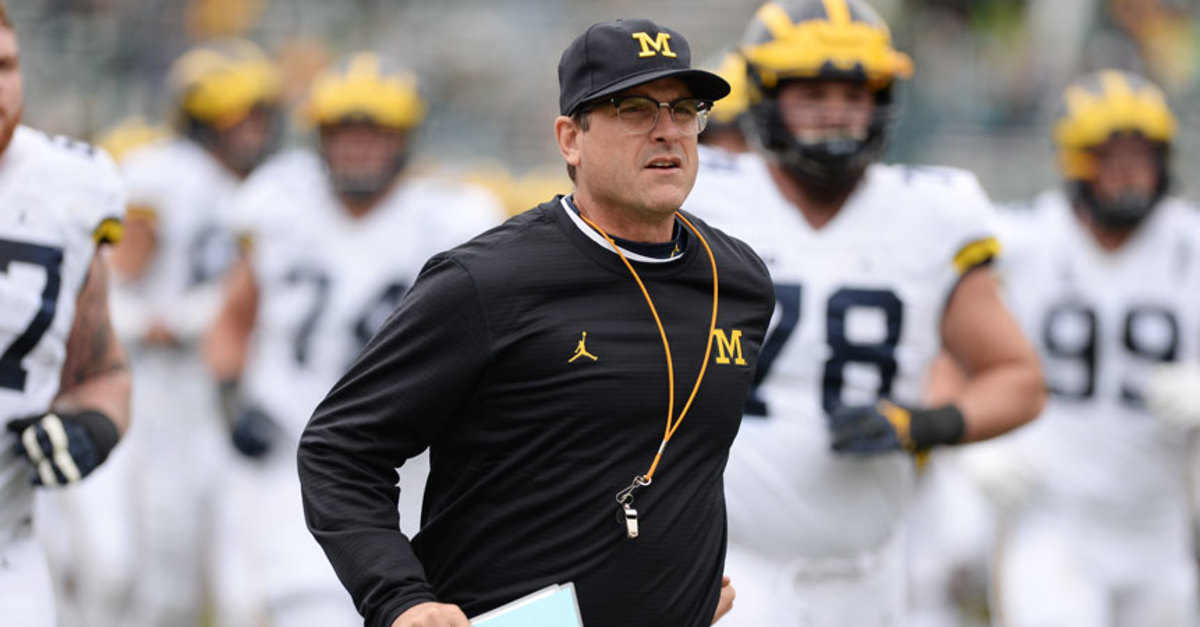
The big breakthroughs
Jim Harbaugh and Michigan
The school got its $9 million worth in Harbaugh, who brought the Wolverines back to championship contention in just his second season. A Nov. 12 injury to junior quarterback Wilton Speight contributed to the losses at Iowa and at Ohio State that undid Michigan’s playoff aspirations, but the Wolverines had a place in the top four of the College Football Playoff rankings going into the final week of the regular season. It took overtime in Columbus to knock the Wolverines out. The off-season hiring of coordinator Don Brown from Boston College contributed to a defensive unit that allowed just 12.5 points per game, second best nationally, and registered 115 tackles for loss in 12 regular-season games, which was the best in the FBS. Brown’s presence, the continued development of the 6’ 6”, 243-pound Speight Speight and ongoing recruiting success (the 2016 class ranked sixth nationally; the ’17 class currently ranks second) seems to ensure that the Big House will be inhabited by a perennial contender once more. Like him or not, Harbaugh will make it a more interesting ride.
Louisville quarterback Lamar Jackson
At ACC media day in July, Jackson noted that his viewing habits mostly revolved around Netflix. We assume that the sophomore has also caught sight of his highlight reels by now. The eight total touchdowns in the season opener against Charlotte introduced a new college football star. The 216 yards passing, 146 yards rushing and five total touchdowns against Florida State in Week 3 confirmed his arrival. By the end of the regular season, the 6’ 3”, 205-pound Jackson accrued 4,928 total yards and 51 total touchdowns and went on to win the Heisman Trophy, despite regular season-ending losses to Houston and Kentucky. It was a striking ascent; over the summer, Jackson and his coach, Bobby Petrino, laughed as they recollected how, during 2015, Jackson had no idea how to run an offense. By the end of 2016, he was clearly the runaway favorite for the sport’s highest individual honor and entirely capable of taking one more run at it in ’17.
Rebels with a wrong cause: Minnesota players chose wrong case to take a stand
The Pac-12 division champions, Washington and Colorado
It’s a stretch to say the power dynamic of the entire conference changed. But maybe no programs emerged as dramatically as did the combatants in the Pac-12 title game. Chris Petersen’s first two years at Washington were a slow, slow build—just 15–14 overall. Then came the detonation: Behind sophomore quarterback Jake Browning and a voracious defense that ranked 10th in Football Outsiders’ defensive S&P+ metric, the Huskies went 12–1, won the Pac-12 and earned the fourth seed in the playoff.
Meanwhile the climb was even more painstaking in the Rocky Mountains. Under Mike MacIntyre, Colorado had won just 10 games in three seasons and just two out of 27 conference tilts. By the end of 2016, the Buffaloes were a 10–3 team and McIntyre was the Pac-12 coach of the year after riding two quarterbacks (Sefo Liufau and Steven Montez) and a steady defense that allowed a manageable 20.5 points per game.
USC and Stanford remain more than viable, and Oregon could reemerge as a contender easily. But the Pac-12’s most high-profile programs had to make room for two more after 2016.
Western Michigan
To properly contextualize the project that P.J. Fleck undertook in Kalamazoo, consider this nugget from a profile written by Sports Illustrated’s Pete Thamel: When Fleck arrived as the Broncos’ coach in Dec. 2012, he put a box full of Western Michigan gear in his car. And any time he saw a student wearing Michigan, Michigan State or Notre Dame clothes on campus—and there were many of them—Fleck stopped the car and handed out Western duds. Once, he literally gave someone the shirt off his back.
By the end of 2016, the 35-year-old Fleck had given this MAC program more than it could have imagined: From a 1–11 debut season to a 13–0 year that included two victories over Big Ten programs (Illinois and Northwestern), the school’s first-ever national ranking (the Broncos climbed as high as No. 12 in the final Associated Press regular season poll) and the first-ever visit from ESPN’s College GameDay. Fleck’s pet phrase, “Row The Boat,” has become a mantra: No matter how difficult things are, put the oar in the water and keep rowing. Of course, the water hasn’t been too choppy in 2016 for Western Michigan, and the only difficulty may have been keeping Fleck around when major-conference suitors came calling. The Broncos won that battle, too.
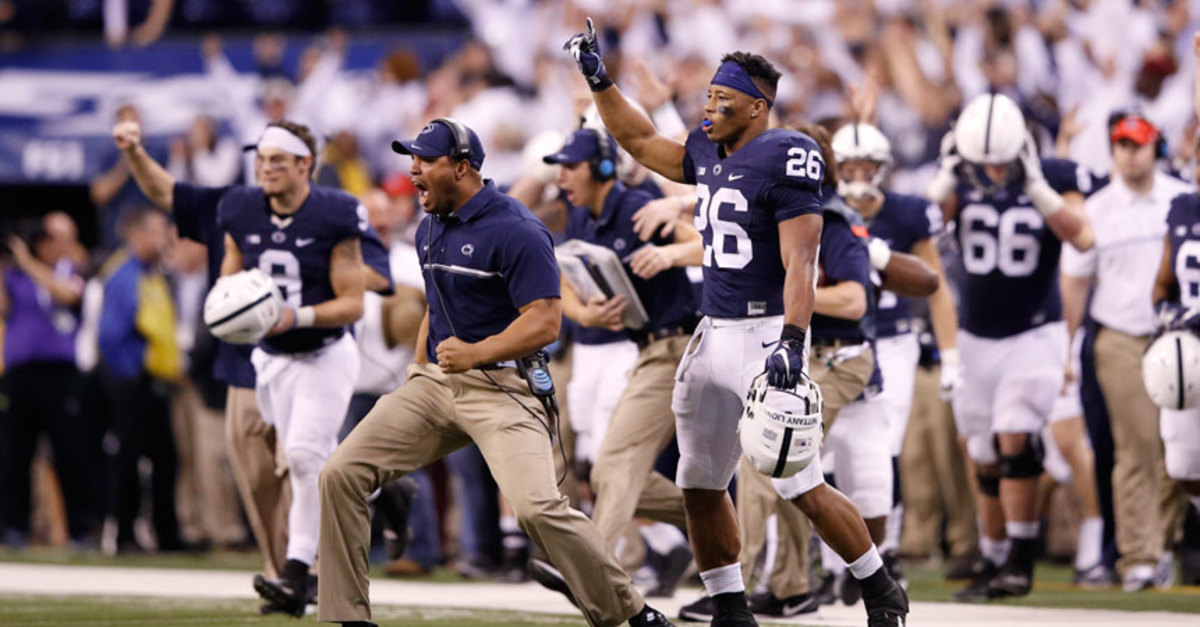
A B1G deal
So much for southern supremacy: Entering the final weekend of November, the Associated Press poll featured not one, not two, but three teams from the Big Ten in the top 5. Ohio State (No. 2), Michigan (No. 3) and Wisconsin (No. 5) combined for a feat not seen in the Big Ten in 56 years. And that didn’t even account for the entirety of the Big Ten’s playoff contenders at that time, with Penn State lurking at No. 8 and sizing up a spot in the league championship game.
In the final playoff rankings, only Ohio State would sneak in, but Penn State, Michigan and Wisconsin all occupied spots in the top 8. Right until the playoff bracket was revealed, the Nittany Lions held out hope for a bid following a dramatic come-from-behind 38–31 victory over the Badgers in the Big Ten title game one night earlier. The dynamic was intriguing not just because the Big Ten managed to overcome its perceived recruiting disadvantages and give itself at least a pretty good shot at becoming the first league to put two (or even three) teams into the College Football Playoff. Mostly it was interesting because it threatened to make Jim Delany, the conference’s commissioner and one of the prime power-brokers in the sport, dance around his own beliefs about who should be included in the playoff.
The case for Alabama to win the College Football Playoff
When the playoff format was being ironed out, Delany was an advocate for league championships holding significant weight in the deliberations. This year, the Big Ten’s highest-ranked team, one-loss Ohio State, had no chance to compete for a league title due to Penn State having the head-to-head tiebreaker over the Buckeyes, which earned the Nittany Lions a spot in Indianapolis. “I was the campaign manager four years ago, for the four best conference champions,” Delany said during a College GameDay appearance on the morning of his league’s semi-meaningful championship game. “We lost that election. What we decided on was the four best teams, which I'm fine with. Obviously, this year is unique in some respects. We have the two divisional champions here today playing for the conference championship, and they should be respected for that. The committee has another role, and that's to pick the four best teams in the country.”
Surely, though, no one at the league offices on the outskirts of Chicago was complaining. The Big Ten was the biggest, baddest league in 2016, and the team that made the playoff field might give it the best shot at a national title anyway.
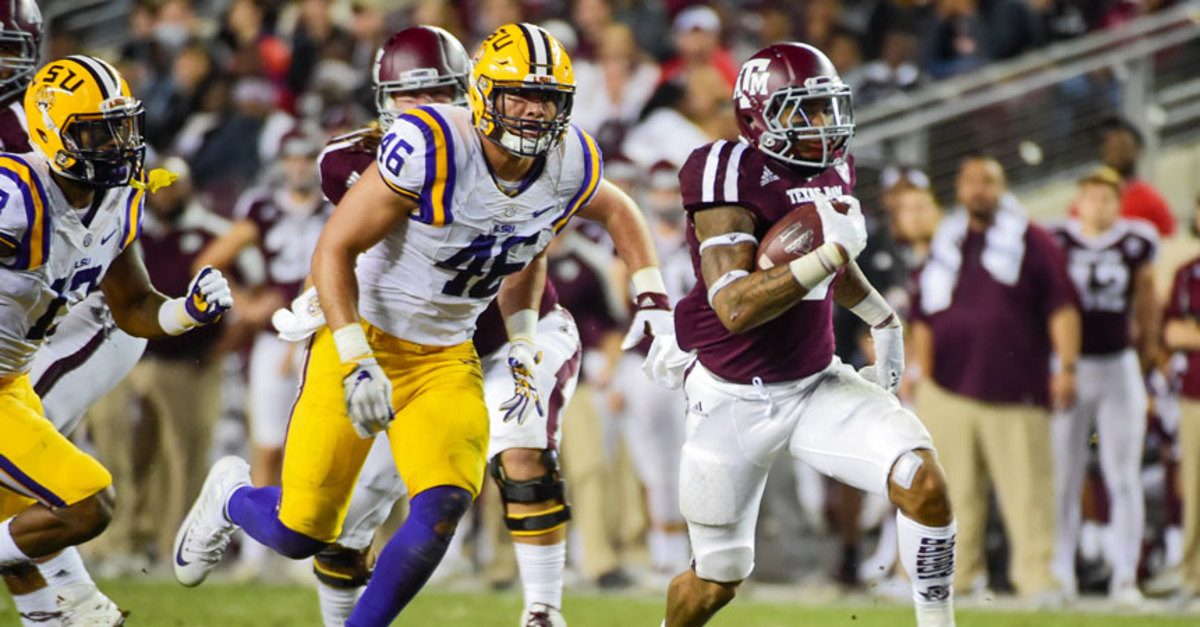
Their future is so bright
The 2016 season gave us more than a glimpse at some true freshman talent that may dominate the landscape for the next two years. It gave us a long look at freshmen already doing some dominating, with the prospect of much more to come. Here they are, in alphabetical order:
Shane Buechele, QB, Texas
As Herman takes over at Texas, he’s gifted the quarterback of the present and future. The 6’ 1”, 191-pound Buechele is the kind of quick-release dynamo that you fit an offense around; his 2,958 passing yards and 21 touchdowns through the air are proof of that.
Rashan Gary, DE, Michigan
The nation’s No. 1 overall recruit in 2016 immediately found a fit in the nation’s No. 1 overall defense, per Football Outsiders’ S&P+ metric, which kept Michigan in the national title hunt until late November. The 6’5”, 287-pound Gary had 27 tackles, including five for a loss, during the regular season. But expect his role—and production—to expand.
Jalen Hurts, QB, Alabama
He’s the first freshman to start at quarterback for Nick Saban and also the primary reason to be terrified of the Tide for the next two years: The 6’ 2”, 209-pounder completed 65.3% of his passes and nevertheless has ample room to improve as a thrower. Yikes.
Dexter Lawrence, DT, Clemson
Performance met potential quick for the 6’ 5”, 340-pound Lawrence, who was the consensus No. 2 prospect in the nation in the Class of 2016. “Dexter reminds me of nobody I’ve ever seen,” Tigers coach Dabo Swinney said before the season. The 59 tackles and 9.5 tackles-for-loss suggested Lawrence indeed may create a category of his own in the next two years.
Ed Oliver, DT, Houston
The 6’ 2”, 290-pound Houston native shouldn’t be considered for freshman All-America teams. He should be considered for All-America status, period, following a havoc-wreaking year in which he recorded 19 tackles-for-loss, including five sacks, and nine passes defended.
Trayveon Williams, RB, Texas A&M
The 5’ 9”, 200-pound Houston native is like a cannonball out of the backfield. His first-year numbers were fairly modest—three 100-yard games, 1,024 yards and eight touchdowns overall—but you’d expect the Aggies to lean on him even more as time goes on.
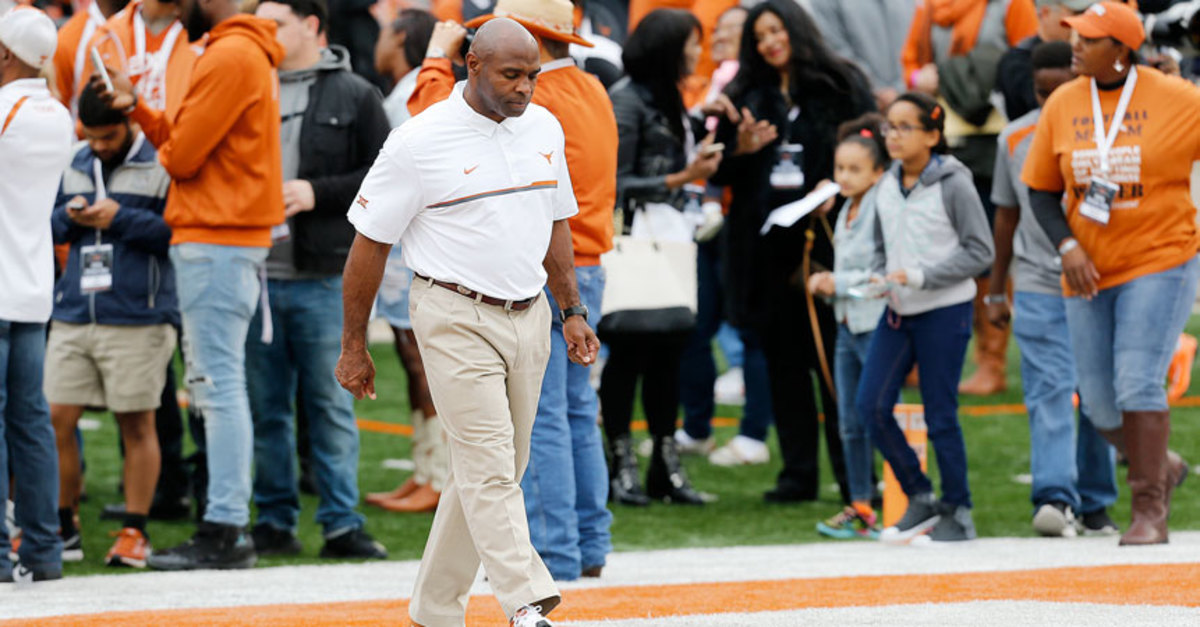
CH-CH-CH-Changes
The 2016 coaching carousel did not spin as wildly as it had the previous fall, when the first change of the season—Illinois axing the embattled Tim Beckman—occurred one week before the seasonbegan. Yes, Baylor similarly fired Art Briles for scandal-related reasons before he got a chance to coach a single game this fall. But that move occurred in May, which hardly qualifies as an abrupt, in-season course correction. No, by the final Monday of the regular season, only three Power 5 schools had jobs that opened during the season or were all but guaranteed to do so: LSU, Texas and Purdue. (Oregon wouldn’t fire Mark Helfrich until Nov. 29, after the regular season concluded.) But that didn’t mean the exits were handled well.
The case for Alabama to win the College Football Playoff
Les Miles kept his job with LSU at the end of 2015 thanks to an almost literal last-minute reprieve from the school president ... and then Miles lasted all of four games in 2016 before receiving his walking papers on Sept. 25. Even if a shakeup was in order, the indecision was dizzying and comical, and the school wound up dancing with Florida State’s Jimbo Fisher and Houston’s Tom Herman to some extent before ultimately settling on a homegrown product in the building already: Ed Orgeron, who served as the interim coach after Miles’ dismissal and then earned the full-time job on Nov. 26. “This is bigger than life,” Orgeron told reporters at his introductory news conference, and LSU can only hope the Larose, La., native can deliver similarly-sized results.
But it’s difficult to build a more stomach-turning roller coaster than Texas can. Charlie Strong was alternately safe or doomed as Longhorns head coach at three or four different intervals during the regular season. Then, on Nov. 19, Texas lost to Kansas for the first time since 1938. And just two days earlier, Herman’s Houston thumped Louisville and Heisman Trophy contender Lamar Jackson on national television. Hours later, reports emerged that Texas decided to fire Strong ... only to have administrators leave Strong out to dry by not confirming or denying any of those obviously accurate reports. He coached through a season-ending loss to TCU and indeed gave way to Herman in the days immediately thereafter. Rarely is the end pretty for any coach, but it doesn’t have to get this ugly.
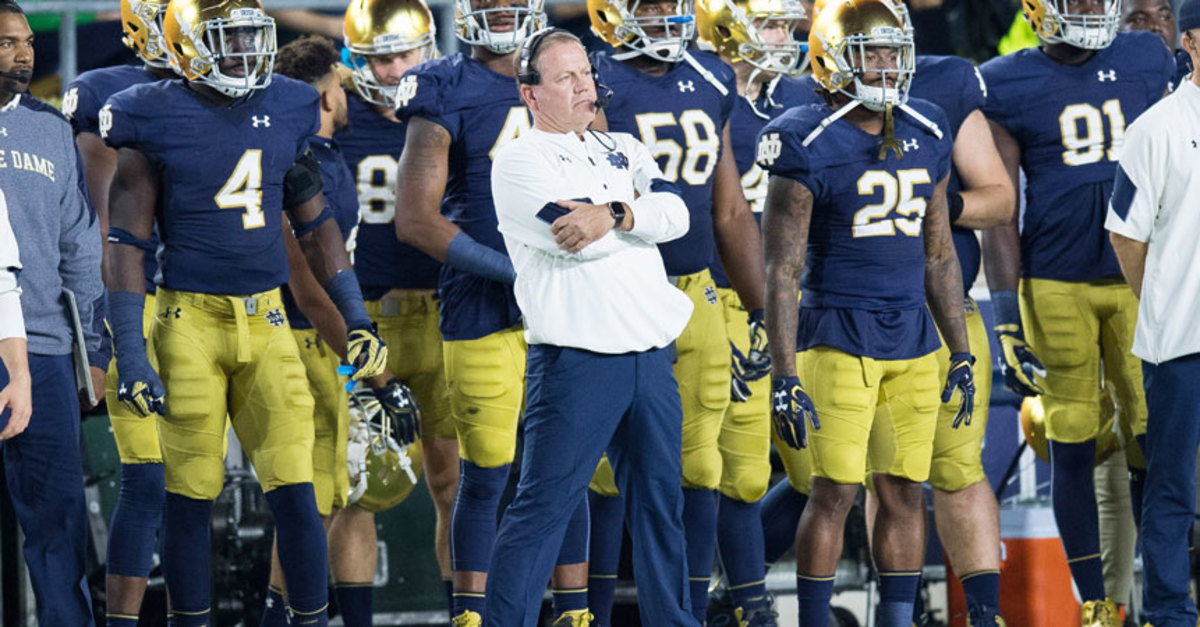
The no-good, awful, very bad years
On Nov. 19, after his team’s seventh loss of the season guaranteed its 14th losing season in 128 years of playing the sport, Notre Dame coach Brian Kelly engaged in some gallows humor. “You know, we're going to wake up from this nightmare and we're going to be 11–0, I think,” Kelly said after his team blew a 17-point lead in a 34–31 loss to Virginia Tech. “Maybe not.”
No, a 4–8 campaign was a waking nightmare for a program that won 10 games the previous season and had been pegged as a potential playoff contender again. The year began with Kelly’s indecision on a starting quarterback effectively costing his team the opening game against Texas. It devolved further as the defense continued to play atrociously and cost coordinator Brian VanGorder his job after four games. And the Fighting Irish simply couldn’t close all season; four of their last five losses were one-possession games. Dreadful campaigns don’t always truly fall at the head coach’s feet, but 2016 did for Kelly: The quarterback quandary, faith in VanGorder and recruiting shortcomings that left the team ill-equipped on defense trace back to him. And though his approval rating wasn’t soaring by the end, reports that his representative poked around at other jobs as possible exit strategies didn’t endear Kelly any more to a salty fan base. Even though he signed a new six-year contract early in 2016, and even though his athletic director backed him unequivocally along the slog, Kelly may need a significant course correction in 2017 to save his job.
Ohio State lifer Luke Fickell set to bring singular focus to Cincinnati
Notre Dame was hardly alone as a prominent, expected-to-thrive program doing a face-plant. Michigan State won 36 games across three seasons and was a College Football Playoff participant in 2015 … and then collapsed, stunningly, to a three-win performance in 2016. The Spartans never had consistent quarterback play while injuries wracked the offensive line. And the defense couldn’t compensate, slipping from 21.7 points per game allowed in 2015 to 27.8 in 2016. No one was hollering for Mark Dantonio’s job—he has a great deal of equity built up for how far along the program has come. But life in the rugged Big Ten East looked remarkably manageable only last winter. Suddenly, and ominously, it seems much more arduous after this season.
No such quiet lasted at Oregon, where the Ducks precipitously plunged to a 4–8 season after winning 11, 13 and nine games in Mark Helfrich’s first three years on the job. There was an argument to be made for patience. Twelve starters in the season finale against Oregon State were sophomores or freshmen, including cornerstones like quarterback Justin Herbert, linebacker Troy Dye and safety Brandon Schooler. But some of the defeats were downright gruesome: A 51–33 defeat at Washington State, a 70–21 bludgeoning by Washington, a 52–27 mauling by Stanford. And there is a stark perception about Helfrich’s recruiting efforts, with none of the top 5 players in Oregon headed to Eugene and just one consensus top-100 defender currently committed for the Class of 2017 talent haul. (Oregon's composite national recruiting rankings for the past three seasons were as follows: 21st in 2014, 16th in 2015, 27th in 2016.) The idea of a rip-roaring program with an endless supply of Nike-sponsored do-dads and gizmos was fading by the end of 2016, and it cost Helfrich his job—the first football coach Oregon had fired since 1976. How soon would these giants pick themselves up off the floor? That was a question for 2017.
